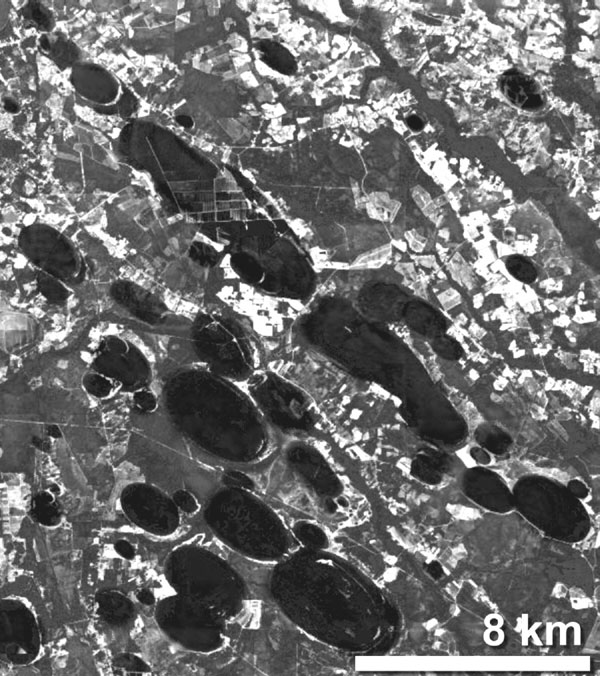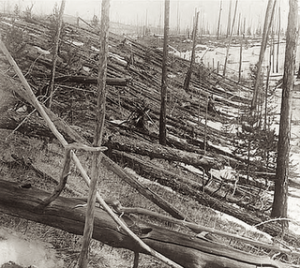USGS
Palmer, Trevor
Trevor Palmer (1944- ) is an English Professor of Biology now living in Scotland. Apart from his day job of enzymology and the study of genetic  disorders, which led to an interest in evolution, which in turn brought him to research catastrophism, he has written several books on these subjects, including >Controversy Catastrophism and Evolution [1971]<Perilous Planet Earth [888], which places today’s “concern about the threat to Earth from asteroids and comets within a historical context.” He devotes two chapters of this comprehensive work to the subject of Atlantis, in which he reviews (chap.13) some of the late 19th and early 20th century theories as well as more recent developments (chap.28) exposing many of the weaknesses in the arguments on offer.
disorders, which led to an interest in evolution, which in turn brought him to research catastrophism, he has written several books on these subjects, including >Controversy Catastrophism and Evolution [1971]<Perilous Planet Earth [888], which places today’s “concern about the threat to Earth from asteroids and comets within a historical context.” He devotes two chapters of this comprehensive work to the subject of Atlantis, in which he reviews (chap.13) some of the late 19th and early 20th century theories as well as more recent developments (chap.28) exposing many of the weaknesses in the arguments on offer.
>A lecture with the same title as the book was delivered to the Society for Interdisciplinary Studies (SIS) in September 2004 and is now available online(m).<
While Palmer does not express any personal views on the subject, it is noteworthy that he wrote an introduction to the 2005 Barnes & Noble edition of Lewis Spence’s The History of Atlantis. After a brief look at Spence’s life, Palmer gives an overview of the principal strands of Atlantology today and concluded that many of the issues debated 80 years ago are still unresolved and for that reason, Spence’s book continues to be worth studying.
Palmer wrote a short paper(a) in 1987 in which he was cautiously sceptical of the Atlantis story, particularly the possibility that it was destroyed during the Late Pleistocene era, with which I concur. He also touched on the subject of the Carolina Bays, apparently adding support to the now-discredited idea that they were created by wind action. I expect that he may have modified his views by now. However, the US Geological Survey is now (2021) identifying the bays as ‘relict thermokarst lakes’.(h)
Palmer presented a paper entitled Catastrophes: The Diluvial Evidence at the Society for Interdisciplinary Studies (SIS) Silver Jubilee Conference in September 1999.(i) He also addressed the SIS in 2004 on the background to his book published the previous year(d).
Palmer published two similar papers in 2010(b) and 2012(e) on the history of catastrophism and the ensuing debates from the time of Velikovsky until the present, when catastrophism has greater acceptance and which now offers a variety of competing ideas regarding the number, source, date and consequences of specific catastrophes.
In the second paper delivered to the Quantavolution Conference on Naxos, he offers the interesting observation that “In science, unlike religion, the great revelations lie in the future; the coming generations are the authorities, and the pupil is greater than the master if he has the gift to see things anew.”
Palmer has also written a 2018 review(c) of Perilous Planet Earth in light of developments since it was first published.
In 2009, Palmer published an interesting paper on the Black Sea and its dramatic connection with the Mediterranean (9,400 years ago) and how it may have influenced the creation of flood myths in the region(l). “The various groups currently investigating the area are agreed that cataclysmic flooding took place during the Late Pleistocene, but remain divided about whether similar floods also occurred during the Holocene. Eye-witness accounts of catastrophic floods in the Black Sea basin at either time could have been passed on to future generations, eventually giving rise to the later Mesopotamian legend of Uta-napishtim and, subsequently, the Biblical story of Noah. However, in the absence of any direct evidence of cultural transmission, that can presently only be regarded as plausible speculation.”
Palmer and Gunnar Heinsohn have been debating Heinsohn’s claim that our chronology of the 1st millennium AD is deeply flawed, on the Q-Mag website(f). Palmer has also written a lengthy paper supporting his views on the matter(g).
In addition, Palmer has also examined the ancient Greek and Roman historians “to test whether they present a picture of the past consistent with that revealed by archaeology, particularly inscriptions indicating sequences and timescales, and also to see the extent to which they support, or otherwise, the orthodox chronology and a number of representative alternative chronologies.” He concluded that there was ‘general accuracy’(j). He subsequently expanded on this paper to include a review of the chronology of the 1st millennium AD(k).
(a) See Archive 3026
(c) Archive 4971 | (atlantipedia.ie)
(d)Archive 4972 | (atlantipedia.ie)
(e) Archive 4973 | (atlantipedia.ie)
(f) https://www.q-mag.org/_search.html?req=Trevor+Palmer
(g) https://www.academia.edu/37544096/Writers_and_Re_Writers_of_First_Millennium_History_Second_draft_October_2018_
(h) https://earthobservatory.nasa.gov/images/147904/ice-age-carolinas
Carolina Bays
The Carolina Bays are named after the bay trees found growing in many of the 500,000 mysterious oval-shaped depressions, principally located in the eastern states of North America. In Maryland, the bays are called Maryland basins. In Mississippi and Alabama, they’re called Grady Ponds. In Kansas and Nebraska, they’re called Rainwater basins. In Texas, they’re called Salinas (because they often contain salty water).
Michael Tuomey (1805-1857) was the Irish-born State Geologist of South Carolina (1844-1847) and first State Geologist of Alalbama (1848-1857). He is credited with being the first to note the distinctive geomorphic features of the bays in a 1848 Report on the Geology of South Carolina (aa).
Allan & Delair have pointed out[014.254] in reference to the time of their creation “the Carolina bays of the eastern United States, the smaller but otherwise closely similar ‘bays’ of Holland, and the aligned ‘lakes’ of north-eastern Siberia, Alaska, northern Yukon and north-eastern Bolivia were apparently produced then.”
Their characteristics have been presented as evidence of impact damage from a comet or asteroid. As early as 1933 Edna Muldrow published a seven-page article in Harper’s Monthly(r) putting forward the idea of a comet colliding with our planet and creating the ‘Bays’. This was probably inspired by a paper by geology professor Frank A. Melton and physics professor William Schiever presented at the 1932 Annual Conference of the Geological Society of America(s).
This view is hotly disputed, as is the idea that they are of relatively recent origin at the beginning of the Holocene. Emilio Spedicato is one proponent who considers that a relatively recent impact to have been a contributory fact to the ending of the last Ice Age leading to the demise of Atlantis.
In 1976, Otto Muck was probably the first to suggest a link between the Carolina bays and Atlantis [098.154-158].
A more mundane explanation has been recently offered by Jon Pelletier, assistant professor of geosciences at the University of Arizona in Tucson. He has just published a paper on a series of uniformly shaped and oriented lakes on the North Slope of Alaska. Pelletier has offered a credible ‘thaw slumping’ rationalisation for their annual growth. However, I have not seen his expla, George A. Howard concluded a paper(x) on the Bays with the following “Given a confident belief that the answers are indeed out there in the sand, we come then to the true shame of the Carolina Bay story: the willingness of the current geophysical research community to tolerate and admit such a profound “mystery” in their midst. I’ve known respected professional earth scientists to brush off questions about Carolina Bays origin with references to “alien landings” and “giant fish.” With prodding, they generally elicit a thin collage of wind and wave theory faintly recalled from their student years. One gets the distinct feeling that the study of Carolina Bay origin is the ‘crazy aunt in the attic’ of the Coastal Plain researcher. And that visiting his dear relative is hardly worth the disturbing consequences.”
The cometary explanation was given additional support in 2007, when a team of researchers from Oregon University outlined evidence that included the Carolinas, for the disintegration of a comet over Eastern Canada around 10900 BC. They claim that apart from the initiation of the Younger Dryas period, it caused widespread destruction across North America and also led to the disappearance of the Clovis culture. Further evidence supporting this view(b) was advanced by other academics in 2008.
A paper by Jennifer Marion completely denies that there was any Holocene Impact that “caused a significant abrupt climate change, extinction event, and termination of the Clovis culture at 12.9 ka.” (v)
Nevertheless, there is also evidence from optically stimulated luminescence (OSL) dating that the bays were formed 80,000 -100,000 years BP, which conflicts with the YD date! My layman’s view is that after 80,000 years I would expect the bays to be much more eroded than they appear to be.
A more recent paper(e) by Antonio Zamora offers an important new concept, namely that the ‘bays’ were created by a meteorite striking the Laurentide Ice Sheet that existed in the Great Lakes region, during the last Ice Age, which in turn produced an enormous hail of ice ejecta which rained down on the eastern seaboard of what is now the United States. In his conclusion, he claims “that the new model of slow-velocity impacts from ice ejecta resulting from a meteorite impact on the Laurentide ice sheet explains many of the characteristics of the Carolina Bays, including the lack of shock metamorphism and meteorite fragments.” Zamora has also published an impressive LiDAR image of a section of the bays, which is best viewed on a large screen(o).
Zamora has also published in 2012 an ebook entitled Meteorite Cluster Impacts [1120](f), and in his 2015 book, Solving the Mystery of the Carolina Bays [1121], he expands on his theory that the ‘Bays’ were created as a result of an extraterrestrial impact with the Laurentide Ice Sheet. He describes in great detail the mathematical basis for his views.
Zamora has now had a new paper on the ‘Bays’ published in the peer-reviewed journal, Geomorphology(i), which may help to rekindle discussion on the subject. Although, in my opinion, they are not directly related to the Atlantis narrative, the existence of the Carolina Bays provides very obvious evidence of our catastrophic past.
Ralph Ellis believes that Zamora’s ‘blocks of ice’ ejecta created by the impact should be thought of instead as being more akin to softer ‘slushballs’(g)(h). Ellis noted that the inspiration for his papers relating to the Bays came from the work of geologist Michael Davias(t). Davias and his friend Tim Harris have been advocating the idea that Michigan’s Saginaw Bay holds evidence of an impact(u).
Robert W. Felix, an American architect totally rejects the ice ejecta theory, principally because the Laurentide Ice Sheet (LIS) should have disappeared before the creation of the Carolina Bays(l). However, conventional wisdom dates the decline of the LIS to around 9,600 BC(m), coincidental with the arrival of the Carolina Bats! Felix contends in one of his books [1688] that the Bays were formed by millions of gigantic explosions in the sky, explosions triggered by a magnetic reversal!
The serial sceptic, Paul Heinrich, claims(d) that there is dating evidence, which indicates varying dates for the creation of different Carolina Bays. The most recent popular work to discuss comprehensively, the origin as well as the conflicting dating evidence for the Carolinas, is The Cycle of Cosmic Catastrophes by Firestone, West and Warwick-Smith. This is an important book that is primarily concerned with a cosmic catastrophe that wiped out the North American mammoth along with other large animals at the same time that the Clovis People disappeared 13,000 years ago. This was also the time of the colder Younger Dryas period.
When the Russian investigator Leonard Kulik studied the Tunguska River area, over which a meteor/asteroid exploded in 1908, he discovered several neat oval bog holes that might offer support for either the impact theory or more improbably the theories of Pelletier.
Now, over a century after the Tunguska event, an Italian research team has concluded that it was an asteroid that struck the earth and that nearby Lake Cheko is the impact crater(c). However, this theory was debunked in 2017 by “researchers led by Denis Rogozin, from the Institute of Biophysics at the Siberian Branch of the Russian Academy of Sciences, carried out their own analysis and concluded that lake sediments were at least 280 to 390 years old, ‘significantly older than the 1908 Tunguska Event.’
And in a new study published May 2 in the journal Doklady Earth Sciences, Rogozin and colleagues presented more evidence to refute the idea Lake Cheko is the Tunguska asteroid’s impact site.”(z)
In 2013 Gernot Spielvogel co-authored Sonnenbomben[1582] in which it is suggested that the Tunguska event was caused by a solar plasma ‘bomb’! Even Nikola Tesla was blamed by some as the perpetrator of the Tunguska event(n).
However, although the impact theory does appear to have widespread support, there appears to be a move to look at a natural earthbound explanation. The U.S. Geological Survey is now identifying the Bays as ‘relict thermokarst lakes’(q).
Such suggestions have been excluded by Paul-Jürgen Hahn who is adamant that the bays were the result of a cometary impact with the Sargasso Sea and was also linked to the Atlantis story and the Pyramids and Sphinx! He gives the date of the impact as “12 March 9,337 BC (Greg.), 10:19 true local time in South Carolina, respectively 09:27 Bahamas time.”(y)
A 2020 article reviews the theories relating to the origin of the bays as well as the extraordinary biodiversity to be found within the bays(p).
Nevertheless, various other theories are still under investigation, including serious consideration of the possibility of an alien spaceship explosion!(j)
Charles O’Dale, a Canadian researcher who has studied impact craters across Canada also ventured south to investigate the Carolina Bays. In a 2022 paper, he includes a number of excerpts from a range of other commentators that highlight the principal details relating to the Bays that are still in contention ninety years after their first discovery(w).
>In 2024, David Anderson, a retired physician, offered another look at the mystery of the Carolina Bays and their creation at the time of the Younger Dryas. In a 2024 paper(ab) on Graham Hancock’s website he reviewed the work of Zamora and Firestone et al and concluded that both offered valuable information, but that some modification was required. However, Anderson saw the catastrophe that created the Bays in a global context, which resulted in his detailed study of the origins of the Hongshan Shui Jing glass and offers evidence to associate them with the Younger Dryas event. He digresses near the end with a suggestion on how the large stones used by megalith builders were moved, which he proposed was done using balloons filled with hydrogen or methane!<
(a) See: Archive 2042
(b) https://www.uc.edu/news/NR.asp?id=8625
(c) https://phys.org/news/2012-05-team-evidence-lake-cheko-impact.html
(d) See: https://atlantipedia.ie/samples/archive-2040/
(e) https://www.scientificpsychic.com/etc/carolina-bays/carolina-bays.html
(g) https://independent.academia.edu/ralphellis4 see (h)
(i) https://www.sciencedirect.com/science/article/pii/S0169555X16308479?np=y (abstract only)
(j) https://www.qconference-athens-2011.grazian-archive.com/aspacekeytotheri/rubtsov-paperx.pdf
(k) https://en.wikipedia.org/wiki/Carolina_bay
(l) Carpet bombing the Carolinas – Ice Age Now (archive.org)
(m) https://study.com/academy/lesson/laurentide-ice-sheet-facts-collapse-timeline.html
(n) https://theunredacted.com/the-tunguska-blast-teslas-death-ray/
(o) https://www.scientificpsychic.com/etc/carolina-bays/carolina-bays-image.html
(p) https://augustamagazine.com/2020/06/30/amazing-carolina-bays/
(q) https://earthobservatory.nasa.gov/images/147904/ice-age-carolinas
(r) The Comet that Struck the Carolinas Harper’s Monthly No.168, 1933. p 87
(s) https://www.jstor.org/stable/30084930
(t) http://cintos.org/index.html
(u) Saginaw Bay fingered by gravity data as ice impact feature – The Cosmic Tusk
(v) (99+) Arguments and Evidence Against a Younger Dryas Impact Event | Jennifer Marlon – Academia.edu
(w) https://craterexplorer.ca/carolina-bays-structure/
(x) The Carolina Bays: George Howard’s Original 1997 Web Essay – The Cosmic Tusk (archive.org)
(y) Die Datierung der Atlantis-Katastrophe (p-j-hahn.de)
(z) The biggest asteroid to hit Earth in recorded history vanished without a trace: How? | Live Science
(aa) https://archive.org/details/reportongeologyo00tuom/page/144/mode/2up [p.143-144]


